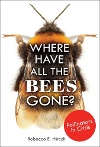The Birds and the Bees
Birds of a Feather. Helen’s Birds. Johnny’s Pheasant. Strange Birds. The Parrot and the Merchant. Fly! Sometimes, particular subjects take off in children’s books. Lately, bird books are soaring, and the office hivemind has noticed bee books gathering, too.
 Birds of a Feather. Helen’s Birds. Johnny’s Pheasant. Strange Birds. The Parrot and the Merchant. Fly! Sometimes, particular subjects take off in children’s books. Lately, bird books are soaring, and the office hivemind has noticed bee books gathering, too.
Birds of a Feather. Helen’s Birds. Johnny’s Pheasant. Strange Birds. The Parrot and the Merchant. Fly! Sometimes, particular subjects take off in children’s books. Lately, bird books are soaring, and the office hivemind has noticed bee books gathering, too.
See Nesting by Henry Cole and Honeybee: The Busy Life of Apis Mellifera by Candace Fleming, illustrated by Eric Rohmann (both in this issue; the latter on our cover, at right), for example. And keep your eagle eyes peeled for more bird and bee books in upcoming issues.
Here are some titles we hope will bee just right for young avian and apian aficionados.
They’ll swarm to them.
Flock to them.
(I’d better duck.)
 Where Have All the Bees Gone?: Pollinators in Crisis
Where Have All the Bees Gone?: Pollinators in Crisis
by Rebecca E. Hirsch; Twenty-First Century
(Intermediate, Middle School)
The answers to why bee populations have dwindled are complicated, and Hirsch explains the processes scientists are using to identify causes of bee population decline. She also shares enough broader ecology to show why we should make it our beeswax to care about bees, with frequent sidebars, diagrams, and photos of bees and their habitats to sweeten the deal.
 Beehive
Beehive
by Jorey Hurley; Wiseman/Simon
(Preschool, Primary)
As in previous titles by Hurley (Nest, Hop), each double-page spread of Beehive contains one word, with a full-bleed digital illustration making it clear what that word means in a bee’s life. The striking lay spread, for example, shows a close-up of a bee adding an egg to a nest; collect shows two busy bees gathering nectar from flowers. An appended author’s note connects these same words to paragraphs expounding on the lives in hives.
 The Thing About Bees: A Love Letter
The Thing About Bees: A Love Letter
by Shabazz Larkin; Readers to Eaters
(Primary)
Larkin expresses love for his sons and for bees; in a poetic text addressing his kids, he admits that both the boys and the bees can sometimes be bothersome, but “we need [bees] just as much / as we need you.” Mixed-media illustrations based partly on photos of Larkin and his family include loose diagrams showing the steps of pollination and a range of bee species from “kind” to “kinda mean.” An unusual mix of science and, well, sweetness.
 Look Down and See: Natural Wonders of the World
Look Down and See: Natural Wonders of the World
by Bethany Lord; Ivy Kids
(Primary, Intermediate)
Lord provides readers with a literal bird’s-eye view of Victoria Falls, the Grand Canyon, Mount Everest, the Serengeti, and more. Each full-bleed double-page spread shows a landscape from the viewpoint of a bird typically found there. “Since birds see things very differently from us, we’ve used our imagination to show a picture of what they could be seeing,” says the introduction. Readers who prefer to flit in and out of books should enjoy the many call-outs with inset maps, facts about each location, and items to search for.
 Ivy Bird
Ivy Bird
by Tania McCartney, illus. by Jess Racklyeft; Blue Dot Kids
(Primary)
Ivy Bird follows a small bird — whose feathers match her young human companion’s red hair — through a day’s activities: paddling with ducks, collecting shiny objects with bowerbirds, chirping with magpies, and so forth. Readers can spot a variety of birds in the vivid mixed-media illustrations, or turn to the back for descriptions of the whole flock.
 Bird Count
Bird Count
by Susan Edwards Richmond, illus. by Stephanie Fizer Coleman; Peachtree
(Primary)
Young narrator Ava and her mother spend a winter day observing and recording the bird species they see as part of the annual Christmas Bird Count (an author’s note explains that the event is run by the National Audubon Society). The text is full of information for fledgling scientists, with species names in bold and more information about each in the back matter. Ava’s tally appears on the side of each spread during the count, allowing readers to watch the list grow as she spots new species.
 I Am Goose!
I Am Goose!
by Dorothia Rohner, illus. by Vanya Nastanlieva; Clarion
(Primary)
The silly-goose protagonist can’t understand why Pig, Fox, and Turtle are chosen as the goose in a Duck, Duck, Goose game. Amid the ridiculously ruffled feathers is a fair amount of information about what makes a goose a goose (webbed feet, feathers, etc.) and a demonstration of how to compare and contrast — in this case, between “A Goose” and “Not a Goose.” The accessible speech-bubble dialogue within the pastel-hued illustrations would make this a good choice for a readers’-theater cast to strut its stuff.
 Seagulls Soar
Seagulls Soar
by April Pulley Sayre, illus. by Kasia Bogdańska; Boyds Mills/Boyds Mills & Kane
(Preschool, Primary)
“Seagulls swerve. / Seagulls soar. / Yack! Yack! Yack! / from ship to shore.” With short rhyming lines somewhat reminiscent of rocking waves, Sayre follows gulls from ocean to desert to dump; informative back matter explains that “seagull is a common name for many species of birds in the family Laridae” and that some spend more time near water than others — but they are all survivors, adapting to changing conditions and habitats. Digital illustrations capture the variety of landscapes (and seascapes, and lakescapes) visited by gulls.
 The Nest That Wren Built
The Nest That Wren Built
by Randi Sonenshine, illus. by Anne Hunter; Candlewick
(Preschool, Primary)
This picture book shows a birdy abode coming together for a wren family, with lots of specifics: snakeskin to scare predators; moss used for lining the nest; an egg sac anticipating spiders that will eat mites. Ink and colored-pencil illustrations in muted colors give close-up views of the nest and its inhabitants, and a glossary and additional “wren facts” further expand the information in the rhyming “House That Jack Built”–like text.
More Books We’re Buzzing and Chirping About
Reviews of the following books can be found in recent issues of The Horn Book Magazine.
Stand on the Sky (Houghton) by Erin Bow (rev. 3/19)
Helen’s Birds (Groundwood) by Sara Cassidy; illus. by Sophie Casson (rev. 1/20)
Nesting (Tegen/HarperCollins) by Henry Cole (rev. 3/20)
Hummingbird (Candlewick) by Nicola Davies; illus. by Jane Ray (rev. 7/19)
Honeybee: The Busy Life of Apis Mellifera (Porter/Holiday) by Candace Fleming; illus. by Eric Rohmann (rev. 3/20)
Swim Swim Sink (Disney-Hyperion) by Jenn Harney (rev. 3/20)
Are You Ready to Hatch an Unusual Chicken? (Knopf) by Kelly Jones; illus. by Katie Kath (rev. 1/19)
Bugs in Danger: Our Vanishing Bees, Butterflies, and Beetles (Bloomsbury) by Mark Kurlansky; illus. by Jia Liu (rev. 11/19)
My Happy Year by E. Bluebird (Holiday) by Paul Meisel (rev. 5/19)
Johnny’s Pheasant (Minnesota) by Cheryl Minnema; illus. by Julie Flett (rev. 1/20)
Karl’s New Beak: 3-D Printing Builds a Bird a Better Life (Smithsonian/Capstone) by Lela Nargi; illus. by Harriet Popham (rev. 5/19)
Dinosaur Feathers (Porter/Holiday) by Dennis Nolan (rev. 11/19)
Strange Birds: A Field Guide to Ruffling Feathers (Kokila/Penguin) by Celia C. Pérez (rev. 9/19)
Birds of a Feather: Bowerbirds and Me (Porter/Holiday) by Susan L. Roth (rev. 9/19)
One Dark Bird (Beach Lane/Simon) by Liz Garton Scanlon; illus. by Frann Preston-Gannon (rev. 7/19)
Extraordinary Birds (Bloomsbury) by Sandy Stark-McGinnis (rev. 5/19)
Not Your Nest! (Dial) by Gideon Sterer; illus. by Andrea Tsurumi (rev. 5/19)
Fly! (Beach Lane/Simon) by Mark Teague (rev. 11/19)
Ducks! (Godwin/Holt) by Deborah Underwood; illus. by T. L. McBeth (rev. 3/20)
The Parrot and the Merchant: A Tale by Rumi (Tiny Owl) retold by Marjan Vafaeian (rev. 9/19)
From the March/April 2020 Horn Book Magazine.

RELATED
ALREADY A SUBSCRIBER? LOG IN
We are currently offering this content for free. Sign up now to activate your personal profile, where you can save articles for future viewing.







Add Comment :-
Be the first reader to comment.
Comment Policy:
Comment should not be empty !!!